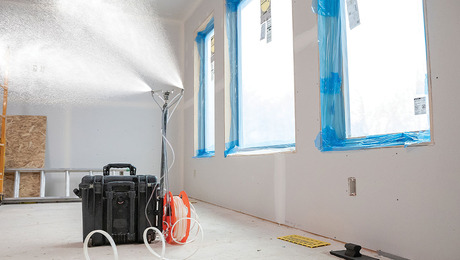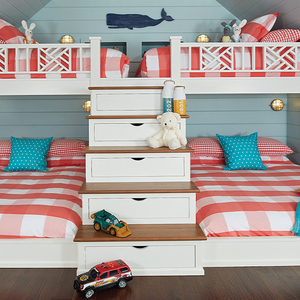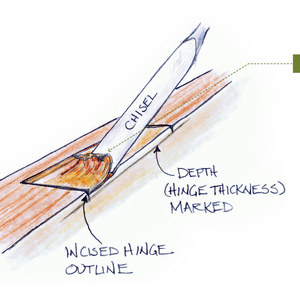I have a summer cottage on a lake in Michigan that was built in the 1930’s and had a couple of small addition added on over the years. It sets on a post foundation. Outside permitter are also post. Floor are uneven and I would like to add a 8’x10′ addition that would give me about 950 sq ft of total living area. I will be replacing the eletrical, pumbing, heating, windows, new bathroom, and updating kitchen. I would like to lift the house and put in a block or concrete crawl space foundation. The house sets about 30 ft from the lake and the ground is all sand. Can’t have a basement. Lot is 37’x100′ My goal is to winterize the home so I can use it in the winter. My question is my idea for the foundation any good. Have not found someone to give me a price to see it this feasible
Discussion Forum
Discussion Forum
Up Next
Video Shorts
Featured Story

Simple air-sealing measures and spray-applied sealant lower energy bills and increase comfort without the need to tear the house apart.
Featured Video
Builder’s Advocate: An Interview With ViewrailHighlights
"I have learned so much thanks to the searchable articles on the FHB website. I can confidently say that I expect to be a life-long subscriber." - M.K.
Fine Homebuilding Magazine
- Home Group
- Antique Trader
- Arts & Crafts Homes
- Bank Note Reporter
- Cabin Life
- Cuisine at Home
- Fine Gardening
- Fine Woodworking
- Green Building Advisor
- Garden Gate
- Horticulture
- Keep Craft Alive
- Log Home Living
- Military Trader/Vehicles
- Numismatic News
- Numismaster
- Old Cars Weekly
- Old House Journal
- Period Homes
- Popular Woodworking
- Script
- ShopNotes
- Sports Collectors Digest
- Threads
- Timber Home Living
- Traditional Building
- Woodsmith
- World Coin News
- Writer's Digest


















Replies
Sounds like a doable project. You'll save quite a bit by not jacking up the whole house at once - even on small houses you're looking at close to $10k for a licenced and insured house lifter to place enough beams to get you up off the ground. Much more economical to do sections and leave the house at it's current elevation. I personally don't care for block foundations and don't recommend them to clients, but it's probably the low cost solution and works well when replacing sections and is probably the route I would take if it were my own house.
30 years ago I worked with a guy who took me by to see his parents house at the beach. It was an old 1920s cottage built on short posts for a foundation. His Mom and Dad had collected bits and pieces of lumber for cribbing and with a single 5 ton hydraulic jack had lifted the house up until it was 9 feet off the ground. They were both in their 70s when they did it and they lived in the house the entire time.
with a single 5 ton hydraulic jack had lifted the house up until it was 9 feet off the ground
My kind of folks - betcha they picked up all the cribbing on the beach as it washed ashore over a few months and did not cost them anything; and, had fun doing it ?
At least where I work it's not possible to lift your own house....permit will only be issued if a licenced and bonded house lifter is used.
Lifting a house is pretty easy, lifting it so walls don't crack is much harder. Lifting a house using one jack is going to be pretty hard on the walls since it's forcing the structure to bend one section at a time. Lifting 1/4" at a time wouldn't be bad, but that's a lot of time to set up, lift and area, shim, move to the next.
I'm reminded of a case that occurred about 15 years ago in The Twin Cities: A guy had a lot that the bank held a mortgage on and he built a house on it. Somehow he fell behind in his mortgage payments or some such and the bank foreclosed. (I think the lot was maybe owned by his business which was in receivership or some such.) The folks at the bank were licking their chops figuring they'd get his house "for free", since there was no mortgage or lien on that, just the lot.
Well, over the period of a couple of weeks, working inside, the guy separated the house (something like a standard 4BR) from its foundation and lifted it up. Then one night he moved it about 2 blocks to another lot he owned free and clear (using trucks he also owned). The bank screamed bloody murder but there was nothing they could do (though I think the city socked him with a modest fine for moving the thing without a permit).
It should be noted that if the posts are sufficiently rot resistant and are driven sufficiently far into the ground that is an excellent foundation. The mere fact that it is a post foundation is not (necessarily) a sign of inferior construction.
Update to crawl space
Since my first post I found a builder to gave me bid. After about 8 weeks of him working on getting me the bid he came in at $28,000 to $31,000 and that it would be opened to other unknow cost. Decided to go and contract this out myself. Found a house mover and a mason. Signed a contract last week and the total came in at $17,500. The mover will raise and lower the home, dig out dirt from under the cottage, remove cement slabs and steps, haul excess dirt from site, and grade site when done. Mason is putting in a 5 block high foundation with a 3 inch floor, 42' high crawl space. This will be a conditioned crawl space with furnace, hot water heater, and well pump. The home is ready to lift but the Michigan weather is not cooperating. Have to wait for the weather to get a little warmer for the mason.
"...conditioned crawlspace..."
How do you plan to insulate block walls and slab floor?
please pay attention......it's a SUMMER cottage.
Note that, whether this remains a summer cottage or not,
the OP says that it will be a conditioned space with a water heater, furnace and well pump. The question about insulation makes perfect sense.
Hey!
How the heck you been, Mark?
Yeah, he did say it was a summer place, but then I thought he said he wanted to make it suitable for winter use.
But whatever, if it's going to be "conditioned" crawlspace, to me that means heated and/or cooled similarly to the living space. Which means it has to be insulated to similar levels. Which means as a do it hisself contractor who got a couple prices he liked from specialists he might want to consider insulating that 3" rat slab and start thinking about wall insulation BEFORE he starts writing checks.
Could retrofit wall insulation pretty effectively. But under that slab? In Michigan? Gonna have a serious heat loss situation through that slab.
But I know you're just saying "hey".
Hey yourself.
Of course, if "conditioned"
Of course, if "conditioned" just means "above freezing" then the standard is lowered quite a bit.
Yeah, you're right, DanH
semantics are critical.
Still, even just minimally conditioned space should be well insulated. Better to spend the extra money once than every month on energy bills (also thinking about resource conservation). When I read through the thread it came to mind so I brought it up.
David Erikson once pointed out to me that certain practices- like widespread use of vinyl products - seemed cost effective because we weren't considering the cost of disposal and cleaning up the environmental costs of manufacture and disposal of vinyl products. Our descendents will. That line of thinking has spilled over into many decisions I make and I benefitted from just that short a discussion - it helped me see things in a different way.
Of course, the foam insulation enventually needs to be disposed of too.
Heat rises. So an uninsulated slab is not that big of a deal. More importantly teh ground under the slab is a heat sink to a degree so not all the heat is truely lost. thirdly to make the situation better, it is not likely the space would be held to 70 degrees, just not freezing. I mean really who is going to heat a 42 inch deep crawlspace? Insulation is a good thing, and in this case teh walls above grade will be teh most important.
I am surprised that 42 inche wall is adequate for Michigan. what is the frost depth?.
Have to disagree with you there, DoRight.
Warm air rises. Warm water rises. Those are examples of "convection".
Another way heat moves is "radiation" -which happens in all directions.
Heat loss down through an uninsulated slab can be significant. And it's pretty hard to insulate under after it's poured. True, the ground beneath it can store some of that heat that radiates through the slab, but the money it will cost to excavate deeper and lay down some rigid foam is a good investment for a slab in any conditioned space.
no one ...
no one does and no one suggests (that I have ever heard) to place anything under a vapor barrier in a vented or unvented crawlspace. Which leads me to beleive the issue of radiant heat loss is minimal. I think some peopel insulate under slabs in basements is because of the expected heat differential between teh earth and the "HEATed" basement space. Compared to teh low temperature desired in a crawlspace. What is your explanation for why no one insulated a crawlspace floor, but they do teh crawlspace walls?
Well...there's lots of things people do, or don't do, that I really can't explain. Lots of standard building practices that I disagree with and have as far back as I can remember.
You say no one suggests insulation under a slab in an unvented crawlspace. I just suggested it. I'm a breathing, thinking person. That makes me someone. And I don't know exactly where, or when I first read, or heard, or thought there should be insulation under a rat slab in a conditioned crawlspace; could have been at The Building Science website, or maybe at the Green Building website Taunton has, or in a book somewhere, or most likely I first read it here on Breaktime. I doubt I came up with on my own, that's for sure.
Conditioned crawlspaces are unusual, at least out here in WA. Local building departments are just recently comfortable specifying what we can and can not do in them. I think they make sense in a lot of ways. I think of them more like foundations with real short walls than as crawlspaces.
In my opinion anytime your are heating a space, even to just keep it above freezing, it's mental energy well spent to consider insulating it. You wouldn't pump warm air into an uninsulated attic space to keep it just barely above freezing, you'd insulate that attic first. The alternative is to need more btus to keep it heated over the life of the building. Just not that hard an argument to make in my opinion.
But honestly, DoRight, even if I could give you a blue link, or refer you to a website or book to "see" for yourself? I wouldn't. I own this opinion. I believe it. Regardless of where I first came across it, or whatever other industry professionals or building scientists say? I believe it. It's self evident. That's enough proof for me.
I say, please pay attention, he would like to WINTERIZE the cabin.
please pay attention......it's a SUMMER cottage.
So you intend to totally drain everything in the fall?
Hey, Mark!
Mark,
How have you been?
Have been trying to find a link to you. Perhaps this is the one.
If you see this, please reply to my email address that you should have.
Thanks!
Bryan Klakamp
From the first post
My goal is to winterize the home so I can use it in the winter.
Joe H
In northern Michigan, footing depth is 42". Depending upon his location on a lake, if he can't have a basement, I'll bet his water table is about 30" or less. Many places around here built on cedar posts and stumps, including some old resort hotels. Insulation under the slab, or at least a 12" perimeter would money well spent.
Another update
I can't put in a basement because the water table is to high. I will be insulating the block walls with sprayed on closed foam insulation and 2"x4'x8' R-10 sheets of foam insulation under the 3 inch concrete floor.
The site is all sand and the frost line is 24 inches.